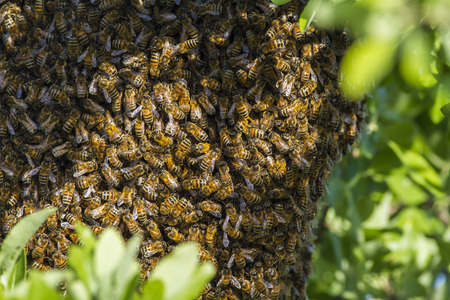Swarm of Bees Grounds Expensive Fighter Jet
August 24, 2016
Bee Colony Collapse, Honey, Honey Bees
When a honeybee hive becomes overcrowded, several eggs within the queen bee’s thousands are provided “royal jelly” to form queen eggs, with the first one to hatch acting as the new queen to a new hive. Once she is bred, half of the original hive flies with the new queen to a new location. At this time, these thousands of now homeless honeybees have to find a safe place for their colony, and it is during this time many hear the story of a "swarm" of bees ending up in an unusual place—a bicycle, a street sign, a tree branch, an old shed, etc.
Swarms either rest in these unusual places, or they decide that spot is perfect for their new hive—a fact that was likely a problem for the maintainers of the 192nd Fighter Wing Aircraft, the most expensive fighter jet in the world and one with a honeybee swarm in the nozzle of its F-22 Raptor engine while sitting in Virginia. Despite many having the initial reaction to find some solution to “get rid” of the bees the same way one gets rid of termites, Tech. Sgt. Jeffrey Baskin, 192nd Maintenance Squadron crew chief, knew the honeybees were too important to be exterminated.
“I was shocked like everyone else because it looked like a cloud of thousands of bees, but I knew they wouldn’t sting anyone and were just looking for a new place to live,” Baskin said. “My neighbor maintains two colonies of honeybees, and I knew they were at risk for extinction. I figured we might want to get a honeybee expert out to collect them.” Since this had never happened before, Capt. Katie Chiarantona, 192nd Aircraft Maintenance Officer, called the on-base entomologist to assess the situation. The entomologist, knowing he didn’t have the means to relocate the swarm, referred a local beekeeper, retired US Navy man Andy Westrich.
Westrich arrived on base with the necessary supplies, and Westrich later claimed the swarm was one of the largest he’d ever seen. He used vacuum hoses to safely remove the honeybees from the engine nozzle and into large buckets. Once he took the bees home, he found the hive weighed eight pounds—calculating to almost 20,000 bees total.
Understanding the bees were simply looking for a new home and were completely harmless as a swarm (who’s only goal is to protect the queen), Westrich safely relocated the misplaced colony to a local beer producer, where the honeybee colony would be maintained and care for, with some of the honey being used for the beer producer’s facility. As Tech. Sgt. Baskin put it, “Every bee is important to our food source; lots of things would die without bees. Most of our crops depend on bees, and our bees need to pollinate. This is why I knew we needed to save them instead of [exterminate] them.”
Copyright: krinaphoto / 123RF Stock Photo


.jpg)




